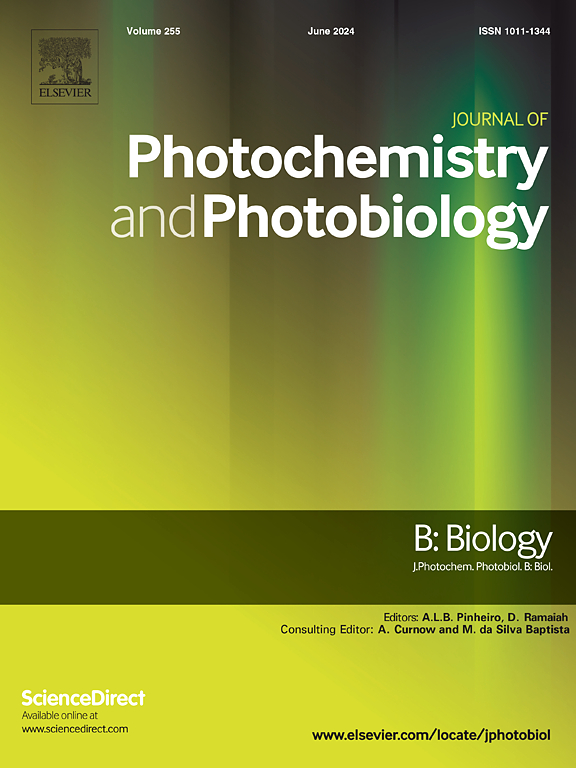In situ sonoporation to enhance the tumour uptake of silicon phthalocyanine and improve PDT effectiveness in a triple negative breast cancer murine model
IF 3.7
2区 生物学
Q2 BIOCHEMISTRY & MOLECULAR BIOLOGY
Journal of photochemistry and photobiology. B, Biology
Pub Date : 2025-09-12
DOI:10.1016/j.jphotobiol.2025.113266
引用次数: 0
Abstract
The effectiveness of photodynamic therapy (PDT) has been well demonstrated in vitro, but in vivo studies have only shown a delay in tumour growth. Tumour recurrence is often reported in clinical trials and is usually associated with limited tumour uptake of the photosensitiser (PS). In this study, sonoporation (SNP) is utilised as a physical targeting tool to enhance the uptake of an untargeted PS in cells and tumour tissues. Using a chemometric approach, we identified the optimal sonoporation stimulus to maximise uptake and cell viability (frequency 1.05 MHz, tON (percentage of positive signal in a single pulse): 50 %, DC: 90 %, burst: 1 s, sonoporation time 1 min). We achieved a viability of 83.9 % ± 10.3, and an uptake in live cells of 53.1 % ± 6.6. The combination of sonoporation and photodynamic therapy resulted in a significant reduction in cell viability. In a triple-negative breast cancer model, sonoporation combined with photodynamic therapy significantly inhibited tumour growth. For the first time, our results highlight the potential of sonoporation as a non-invasive method to increase the intratumour uptake of photosensitisers, offering a promising strategy to improve PDT efficacy.

原位超声穿孔增强肿瘤对硅酞菁的摄取并改善三阴性乳腺癌小鼠模型的PDT效果。
光动力疗法(PDT)的有效性已经在体外得到了很好的证明,但在体内的研究只显示了肿瘤生长的延迟。肿瘤复发经常在临床试验中报道,通常与有限的肿瘤摄取光敏剂(PS)有关。在本研究中,sonoporization (SNP)被用作物理靶向工具,以增强细胞和肿瘤组织中非靶向PS的摄取。使用化学测量方法,我们确定了最佳的声穿孔刺激,以最大限度地提高摄取和细胞活力(频率1.05 MHz, tON(单脉冲中阳性信号的百分比):50%,DC: 90%,爆发:1秒,声穿孔时间1分钟)。我们获得了83.9%±10.3%的活力,53.1%±6.6的活细胞摄取。声波穿孔和光动力疗法的结合导致细胞活力显著降低。在三阴性乳腺癌模型中,超声穿孔联合光动力疗法显著抑制肿瘤生长。我们的研究结果首次强调了超声穿孔作为一种非侵入性方法增加肿瘤内光敏剂摄取的潜力,为提高PDT疗效提供了一种有希望的策略。
本文章由计算机程序翻译,如有差异,请以英文原文为准。
求助全文
约1分钟内获得全文
求助全文
来源期刊
CiteScore
12.10
自引率
1.90%
发文量
161
审稿时长
37 days
期刊介绍:
The Journal of Photochemistry and Photobiology B: Biology provides a forum for the publication of papers relating to the various aspects of photobiology, as well as a means for communication in this multidisciplinary field.
The scope includes:
- Bioluminescence
- Chronobiology
- DNA repair
- Environmental photobiology
- Nanotechnology in photobiology
- Photocarcinogenesis
- Photochemistry of biomolecules
- Photodynamic therapy
- Photomedicine
- Photomorphogenesis
- Photomovement
- Photoreception
- Photosensitization
- Photosynthesis
- Phototechnology
- Spectroscopy of biological systems
- UV and visible radiation effects and vision.

 求助内容:
求助内容: 应助结果提醒方式:
应助结果提醒方式:


